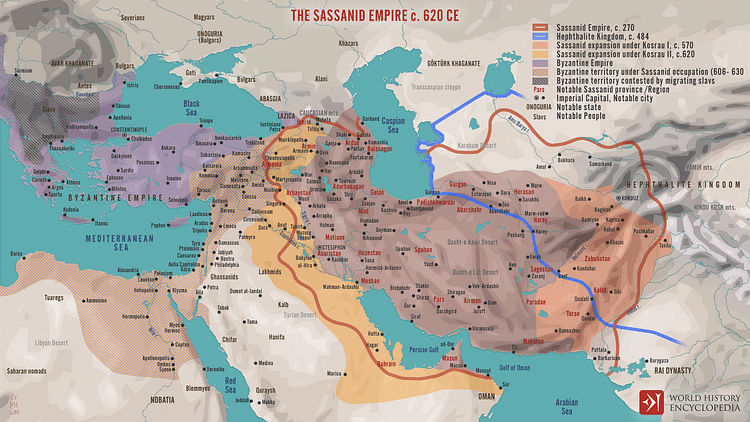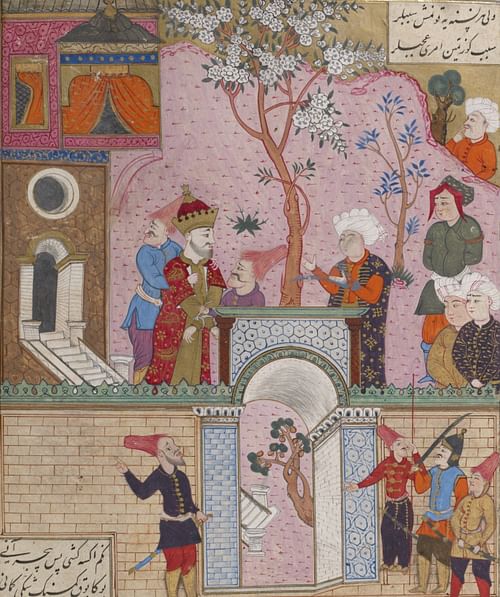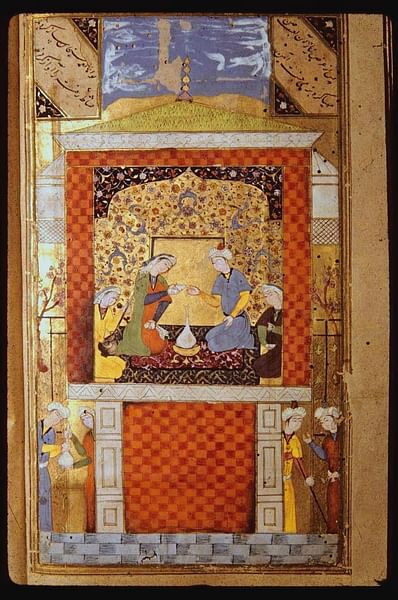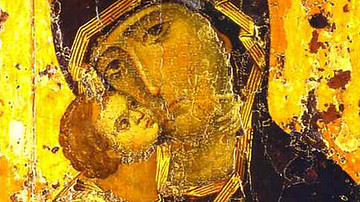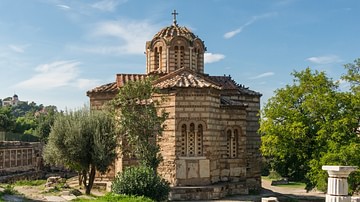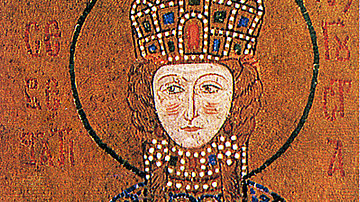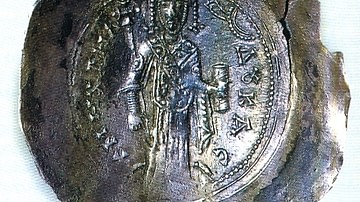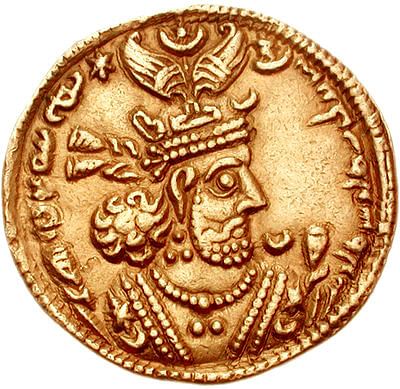
Khosrow II (aka Kosrau II, r. 590-628) was the last powerful shahanshah (king of kings) of the Sassanian Empire. Grandson of Kosrau I (r. 531-579) and near-conqueror of the Byzantine Empire in the Byzantine-Sassanian War of 602-628, Khosrow II was a devout Zoroastrian, whose favorite wife, Shireen, was a Christian. His reign marks the end of classical Zoroastrian culture before the Islamic conquest of modern-day Iran in 651.
Rise to Power
Khosrow II's father and predecessor, Hormizd IV (r. 570-590), sent his general Bahram Chobin to subdue the hordes of Turkish horsemen who were threatening the Persian Empire. While Chobin successfully ended the threat, Hormizd IV insulted him for losing a minor battle. Chobin was enraged and rebelled against the Sassanian dynasty, the family that had ruled ancient Persia since 224 CE. Then, Khosrow II's uncles, Vistam and Vindoe, also rose in rebellion. The brothers put out Hormizd IV's eye with a red-hot poker.
Chobin, wanting to weaken the Sassanian dynasty, began rumors that Khosrow II was behind the maiming of Hormizd IV, and he began minting coins in the prince's name. He also claimed that his rebellion was a campaign to avenge the mutilation of Hormizd IV. Khosrow II fled Persia, only to have his small force defeated in battle by Chobin. Hunted and alone, Khosrow went back to the imperial capital of Ctesiphon and pleaded his case, promising that he was not behind any rebellion. Hormizd IV believed his son, and both agreed to first deal with Chobin, the greater threat, and then punish Vistam and Vindoe. Hormizd IV urged Khosrow II to flee and ask the Byzantine emperor, Maurice (r. 582-602), for aid. Meanwhile, Vistam and Vindoe snuck back to Ctesiphon and murdered Hormizd IV. It is still debated whether Khosrow II knew of Vistam and Vindoe's plans to murder Hormizd IV or not. Chobin then assumed the throne, the first time in 400 years that someone not from the Sassanian dynasty ruled Iran.
Khosrow II continued to the Byzantine Empire and reached the city of Circesium. He wrote to Maurice, promising Persian territory in the Caucasus region and the cities of Dara and Amid to the Byzantine Empire in return for an army and support to regain the throne. Maurice agreed, and with Byzantine support, Khosrow II expelled Chobin and reclaimed the throne. He then ordered the execution of his uncles, Vistam and Vindoe, however, both fled.
Byzantine-Sassanian War
Khosrow II's throne was now secure, but Maurice faced a rebellion in his capital, Constantinople. Phocas (r. 602-610) took the Byzantine throne by murdering Maurice and his entire family. Furious and vowing to avenge his ally's death, Khosrow II ordered his army into Byzantine territory in 602, thus starting the Byzantine-Sassanian War of 602-628. They captured city after city, even conquering Chalcedon in 608, a city separated from Constantinople only by the narrow Bosphorus Strait.
As further Byzantine territory was lost and Phocas became cruel, another rebellion broke out in 610. Heraclius the Elder, a Byzantine imperial official from Africa, led his army to Constantinople. Phocas was assassinated, and Heraclius, the son of Heraclius the Elder, was proclaimed emperor in his place. Heraclius tried to offer peace to Khosrow II, but he refused. By now, Khosrow II's goal was to conquer the Byzantine Empire.
With the capture of Jerusalem in 614, the Persians also took the True Cross, which Christians believed was the actual cross used at the trial and crucifixion of Jesus of Nazareth. The loss of the True Cross caused panic and anger among the Christians of the Byzantine Empire. Christians in ancient Persia, however, rejoiced when the True Cross was brought to Ctesiphon. At this time, Persia had many Christians who did not follow the type of Christianity found in the Byzantine Empire and differed in their opinion about the trinity and Jesus' human nature and divinity.
Khosrow II's armies kept the pressure on the Byzantines, conquering Egypt in 618 and cutting off Constantinople from essential grain supply. Heraclius, being desperate, turned the war from one of Byzantine survival to that of a holy war. He began painting Khosrow II as anti-Christian, saying that he desecrated the True Cross and mocked Jesus Christ. In 624, Heraclius, with help from the Turks, personally led a Byzantine invasion of Persia through the Caucasus. Khosrow II's armies tried to besiege Constantinople in 626 but were unsuccessful.
Downfall
In Persia, the armies of Heraclius destroyed many important Zoroastrian holy sites and killed many people as they marched to Ctesiphon. Khosrow II had no choice but to recall his army from Byzantine territory to defend his empire. The destruction caused by the Byzantine army and the untold money spent on a war turned public opinion against Khosrow II. The stage was set for his downfall.
The Byzantines intercepted a letter from Khosrow II to one of his generals, Shahbaraz. They altered the letter, turning it into an execution order for Shahbaraz, which they sent to the general. After it was delivered, Shahbaraz betrayed Khosrow II and agreed to stay out of the war. In 627 at Nineveh, the Byzantines soundly defeated the Persians, and Khosrow II fled to his palace at Ctesiphon.
Heraclius then secretly met the Persian elites who were tired of almost 30 years of war. They agreed to remove Khosrow II from the throne if Heraclius promised to stop the fighting. Heraclius agreed. In 628, those elites freed one of Khosrow II's sons, Sheroe (also given as Shiroe), who had been imprisoned because Khosrow II believed he would take the throne for himself. In the dead of night, shouts around Ctesiphon declared Sheroe as king of kings, Kavad II (r. 628 CE). Ctesiphon was abuzz with the news, and the excitement woke Khosrow II from his sleep. His favorite wife, Shireen (also given as Shirin), urged him to flee, but Khosrow II dressed in his finest armor instead and awaited the conspirators in the gardens of his palace in Ctesiphon. Khosrow II was arrested and charged with misconduct during his reign, especially in raising taxes to cover the costs of the war. He was executed, along with all of his other children, and Sheroe then formalized peace with the Byzantines. His reign, however, was short, and it set the stage for a series of weak rulers until the Islamic conquest.
Personal Life
Khosrow II had multiple wives. One of them was Maryam, a Byzantine noblewoman, who, according to some sources, was the daughter of Maurice; she was also the mother of Sheroe. His other wife was Kurdiyah, the sister of Bahram Chobin. Finally, his favorite wife was Shireen, a Christian who, according to some sources, came from Armenia.
Khosrow II and Shireen's relationship began when both were young, only to be interrupted by Bahram Chobin's rebellion and Khosrow II's flight to the Byzantine Empire. After Khosrow gained the throne, he and Shireen reunited and resumed their romance. Soon after, Shireen became pregnant. Khosrow II, a faithful Zoroastrian, sent money and a letter to the Shrine of Sergius, a Christian martyr who had died in the early 4th century. In this letter, Khosrow II wrote that he had appealed to Sergius for divine aid so Shireen could become pregnant, and the letter and money to his shrine were in appreciation of his help. Although he was a Zoroastrian monarch, he also allowed Shireen to preach Christianity in Ctesiphon and sing hymns at court in defiance of ancient Persian law and custom. Shireen was also at Khosrow II's side during his entire war with the Byzantines. After Khosrow II's execution, she committed suicide.
Religion
Khosrow II ruled an empire with the largest number of Christians the world had ever seen up until that point. Although he waged a war against the Christian Byzantine Empire, he understood the Christians of Persia and what they believed in, which differed from the Christians of the Byzantine Empire. Even though he believed in Zoroastrianism, Khosrow II knew that he needed the support of the people of his empire, including Christians. Besides his favorite wife, one of his most trusted advisors and minister of finance, Yazdin, was a Christian, too. Khosrow II even presided over the East-Syrian Synod of 605, which met to appoint the leader of Christians in Persia. The bishops who met at this meeting also proclaimed their loyalty to Khosrow II.
Conclusion
Khosrow II was the last powerful ruler of Persia before the arrival of Islam, and he almost conquered the Byzantine Empire. After Khosrow II's execution and Persia's defeat in the Byzantine-Sassanian War of 602-628, a series of weak rulers could not restore the Persian Empire to its former glory and power. The Byzantines were also weakened and so neither of them could mount a sufficient defense when the Islamic armies poured out of Arabia. The Muslim armies invaded Persia in 633, and by 636, the Muslim conquest was complete with their victory at the Battle of al-Qadisiyya. The last king of kings of the Sassanian dynasty, Yazdegerd III (r. 632-651), fled Ctesiphon and was assassinated in 651.
